Summary
Nautilus pompilius can rotate its eye relative to its body so as to compensate for changes in its body orientation and maintain its eye fixed with respect to gravity. An ocular compensation reflex stabilizes its eye about the pitch axis against the rocking motions that occur as the animal swims by jet propulsion. The eye is not held absolutely still, as 1–2° spontaneous rotations occur even if the animal is clamped.
If the animal is held in an unnatural orientation (rotated about the axis through its laterally directed eyes) the counterrotation of the eye is maintained for many minutes; it may compensate for 50–90% of imposed tilts up to ±30°. If the nautilus is tilted suddenly forward or backward, its compensation reflex is 50% complete within 0.3 s, and is complete in 1–2 s. The time course of the responses explains how the eye, during the 1 Hz rocking caused by swimming, can be held fixed in space to within 1–4°. The ocular compensation of each eye is mediated largely by the homolateral statocyst, as is shown by unilateral and bilateral ablation. The effect of ocular compensation is to keep image orientation on the retina fixed relative to gravity, and to prevent large rotational image motions from being caused by the nautilus's own swimming.
Similar content being viewed by others
References
Bidder, A.M.: Use of the tentacles, swimming, and buoyancy control in the pearly nautilus. Nature196, 451–454 (1962)
Boycott, B.B.: The functioning of the statocysts ofOctopus vulgaris. Proc. R. Soc. Lond. (Biol.)152, 78–87 (1960)
Budelmann, B.U.: Die Arbeitsweise der Statolithenorgane vonOctopus vulgaris. Z. Vergl. Physiol.70, 278–312 (1970)
Budelmann, B.U.: Gravity receptor function in cephalopods with particular reference toSepia officinalis. Fortschr. Zool.23, 84–96 (1975)
Budelmann, B.U.: Equilibrium receptor systems in molluscs. In: Structure and function of proprioceptors in the invertebrates. Mill, P.J. (ed.), pp. 529–566. London: Chapman and Hall 1976
Cohen, B.: Vestibulo-ocular relations. In: The control of eye movements. Bach-y-Rita, P., Coffins, C.C., Hyde, J.E. (eds.), pp. 105–148. New York: Academic Press 1971
Collewijn, H.: Oculomotor reactions in the cuttlefish,Sepia officinalis. J. Exp. Biol.52, 369–384 (1970)
Denton, E.J., Nichol, J.A.C.: On the buoyancy of the pearly nautilus. J. Mar. Biol. Assoc. U.K.46, 723–759 (1966)
Dijkgraaf, S.: The statocyst ofOctopus vulgaris as a rotation receptor. Pubbl. Staz. Zool. Napoli32, 64–87 (1961)
Dijkgraaf, S., Hessels, H.G.A.: Über Bau und Funktion der Statocyste bei der Schnecke,Aplysia limacina. Z. Vergl. Physiol.62, 38–60 (1969)
Fröhlich, A.: Studien über die Statocysten. I. Versuche an Cephalopoden und Einschlägiges aus der menschlichen Pathologie. Pflügers Arch. ges. Physiol.102, 415–472 (1904)
Haven, N.: The ecology and behavior ofNautilus pompilius in the Philippines. Veliger15, 75–80 (1972)
Heath, J.E., Northcutt, R.G., Barber, R.P.: Rotational optokinesis in reptiles and its bearing on pupillary shape. Z. Vergl. Physiol.62, 75–85 (1969)
Holst, E. von: Die Arbeitsweise des Statolithenapparates bei Fischen. Z. Vergl. Physiol.32, 60–120 (1950)
Hurley, A.C., Lange, G.D., Hartline, P.H.: The adjustable “pinhole camera” eyeof Nautilus. J. Exp. Zool.205, 37–43 (1978)
Jong, H.A.A. de, Wilgenburg, H. van: Signal transmission of statocyst information in the central nervous system of the molluscsHelix andAplysia. Fortschr. Zool.23, 51–62 (1975)
Muskens, L.J.J.: Über eine eigentümliche compensatorische Augenbewegung der Octopoden mit Bemerkungen über deren Zwangsbewegungen. Arch. Anat. Physiol.28, 49–56 (1904)
Schöne, H., Budelmann, B.U.: The function of the gravity receptors inOctopus vulgaris. Nature226, 864–865 (1970)
Sutherland, N.S.: The visual system ofOctopus — Theories of shape discrimination inOctopus. Nature186, 840–844 (1960)
Walls, G.L.: The vertebrate eye and its adaptive radiation. Bloomfield Hills: Cranbrook Institute of Science 1942
Wells, M.J.: Proprioception and visual discrimination of orientation inOctopus. J. Exp. Biol.37, 489–499 (1960)
Wells, M.J.: Brain and behavior in cephalopods. Stanford: Stanford University Press 1962
Willey, A.: Contributions to the Natural History of the pearly nautilus. In: Zoological results based on material from New Britain, New Guinea, Loyalty Islands and elsewhere collected during the years 1895, 1896, and 1897. Part 6, pp. 691–827. Cambridge: Cambridge University Press 1902
Wolff, H.G.: Multidirectional sensitivity of statocyst receptor cells of the opisthobranch gastropodAplysia limacina. Mar. Behav. Physiol.1, 361–373 (1973)
Wolff, H.G.: Statocysts and geotactic behaviour in gastropod molluscs. Fortschr. Zool.23, 63–84 (1975)
Young, J.Z.: The central nervous system ofNautilus. Philos. Trans. R. Soc. Lond. (Biol.)249, 1–25 (1965)
Author information
Authors and Affiliations
Additional information
This work would not have been possible without the fishing skill and the hospitality of the people of Bindoy, Negros Oriental, The Republic of the Philippines. We especially thank Mr. Wilson Vailoces who arranged for capture of experimental animals. We are indebted to Mr. Walter Schneider for his technical assistance on shipboard. This study, a part of the RV Alpha Helix Southeast Asian Expedition was supported by the National Science Foundation under grants of 74-01883 and OCE 74-02888 to the Scripps Institution of Oceanography and BM 575-01149 to Iowa State University. NIH Grant R01-EY01539 to P. Hartline supported data analyses.
Rights and permissions
About this article
Cite this article
Hartline, P.H., Hurley, A.C. & Lange, G.D. Eye stabilization by statocyst mediated oculomotor reflex inNautilus . J. Comp. Physiol. 132, 117–126 (1979). https://doi.org/10.1007/BF00610715
Accepted:
Issue Date:
DOI: https://doi.org/10.1007/BF00610715




